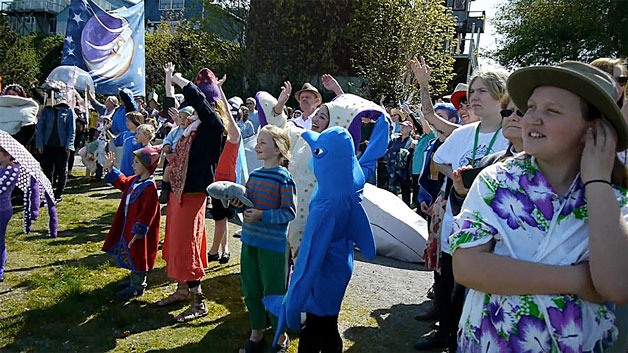Critters, children and people of all ages, shapes and sizes gathered on Saturday, April 16, to celebrate the arrival of the gray whales that have visited South Whidbey shores for the past 25 years.
The 2016 Welcome the Whales Festival brought the inner Orca, dolphin and other sea creatures out of those who attended the parade as they marched throughout downtown Langley to Waterfront Park. It was a scene that could have been taken out of a Halloween celebration.
Attendees were celebrating the Saratoga gray whales, or the North Puget Sound gray whales, who feed on ghost shrimp in the mud flats of Saratoga Passage and Possession Sound typically through the end of May. The group of whales that come this way number about a dozen, and frequent these waters so often that local whale experts have come to know them by name.
“I just think it’s thrilling to know there are whales that come right here to our shores every year and we are getting to know them better and better each year,” said Howard Garrett, co-director of Orca Network, which sponsored the event.
A specialized annual eating habit like this is unheard of in the world of gray whales. The whales are naturally almost always in transit, traveling thousands of miles up and down the Pacific Coast seeking the best feeding grounds, yet these dozen or so whales have specialized eating habits in these waters unlike any other micro-population to scientists’ knowledge, according to Garrett.
Following the costume-clad parade, there was a blessing for the whales at the waterfront Whale Bell Park as scores of people shouted, “We welcome you, whales.” South Whidbey locals found numerous other ways to celebrate the massive marine mammals, including an original song by a young female singer-songwriter.
“It was a fitting anthem, full of heart and originality and included mention of the orcas currently held in captivity,” said Greta Taxis, a festival-goer and videographer from Olympia. “I didn’t expect to encounter such joy and delight. There was such as commitment among everyone to celebrate and I was deeply touched by that.”
Once the festivities along the waterfront came to a close, a presentation on the most recent findings of gray whale behavior was delivered by John Calambokidis of Cascadia Research, an Olympia-based non-profit scientific and educational organization that conducts research to manage and protect threatened marine mammals. Calambokidis demonstrated the group’s method for monitoring whale behavior; they use a video camera that latches onto the whales’ backs using suction cups and a long pole to reach the whale. Once the video camera is lightly smacked on their humungous backs, the whales react by submerging themselves in the water, and footage is shot from a dorsal view.
Calambokidis’ research illustrated the social nature of gray whales, which has largely been undocumented until now. The whales often swim right next to one another in twos and threes, and brush their fellow whales on the back with their pectoral fins as if to say hi. These whales even interacted extensively with the small boats Cascadia Research used to study them.
“The presentation was fantastic,” Garrett said. “There was so much new information, and it opened up a social aspect from the whales that we’ve never seen before. They’re really social animals and acutely aware of everything around them.”
On Sunday, April 17, Welcome the Whales featured Orca Network’s gray whale fundraising cruise on the Mystic Sea whale watch boat.
According to Jill Hein, Orca Network board member, it’s important to celebrate the whales and know that they frequent these waters annually and come right by the shores of Whidbey Island. The bond between Whidbey and the whales, she says, is close due to the 30 or so years of tracking this specific group of gray whales.
“We really have a treasure here and people on Whidbey Island are becoming aware of this amazing phenomenon that’s happening right in our backyards,” Garrett said.



